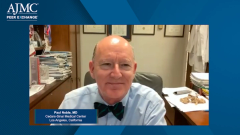
Treatment Landscape Surrounding Anti-Fibrotic Agents
Dr Noble, MD provides and overview of the treatment landscape surrounding ILD, specifically examining IPF, PPF, and SSc-ILD antifibrotic therapy.
Episodes in this series

Paul Noble, MD: Nintedanib is a multikinase inhibitor. Originally, it was developed to treat cancers. There are a number of anticancer drugs on the market that target a number of kinases. Nintedanib targets tyrosine kinases in particular. There are multiple kinases. We don’t know exactly what pirfenidone’s mechanism of action is. It was identified as a molecule in screening that could slow the development of fibrosis in animal models, but the precise molecular mechanism has been elusive. One major molecule that we believe drives fibrosis is a growth factor called transforming growth factor beta. There’s some laboratory evidence that pirfenidone may inhibit some of the ability of transforming growth factor beta to promote fibrosis.
What I mean by fibrosis is that this is fibrosis in a dish. The cells that make matrix, collagen in particular, are called fibroblasts. Fibroblasts are important for normal wound healing. But what we believe happens in fibrotic lung diseases is these fibroblasts are persistently activated to make matrix molecules, including collagens, proteoglycans, and other matrix molecules, that essentially accumulate in the interstitium of the lung. The interstitium is where the action is. That’s where gas exchange happens. The job of the lung is to take oxygen from the air and get it into the blood. When there’s a thickening of matrix deposition in the interstitium, it makes it more difficult for gas exchange to happen, which leads to a decline in lung function. Nintedanib and pirfenidone are generally believed to make it more difficult for these fibroblasts to make matrix and collagen in particular.
What’s the impact of having a drug that will be utilized across the spectrum? It’s useful, but there are also significant limitations. The challenge with all these diseases—IPF [idiopathic pulmonary fibrosis], connective tissue disease, hypersensitivity pneumonitis—is that nintedanib is targeting very late sequelae in the process. The underlying cause for IPF appears to be a failure of the alveolar type 2 cell, which is the stem cell in the alveolar space where gas exchange happens. When these cells die, there’s a process that leads to fibroblast recruitment activation and matrix deposition. But the horse is out of the barn at that point. Nintedanib makes it more difficult for these fibroblasts to make collagen, but it doesn’t treat the underlying disease. Patients aren’t going to get better.
Diagnosing them early and then trying to prevent progression of the disease is the standard of care. It’s similar for these other fibrotic lung diseases that are included under the column of progressive pulmonary fibrosis. Nintedanib doesn’t treat the underlying cause, but it slows the loss of lung function. I hope we’re going to begin to see drugs that raise our expectations for clinical trials with IPF. We should strive for more than finding better-tolerated drugs that slow the loss of FVC [forced vital capacity]. We should strive for drugs that improve lung function and make people function better and live longer.
Transcript edited for clarity.
Newsletter
Stay ahead of policy, cost, and value—subscribe to AJMC for expert insights at the intersection of clinical care and health economics.






























































